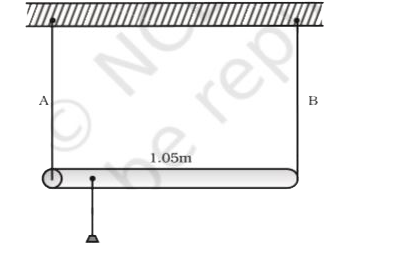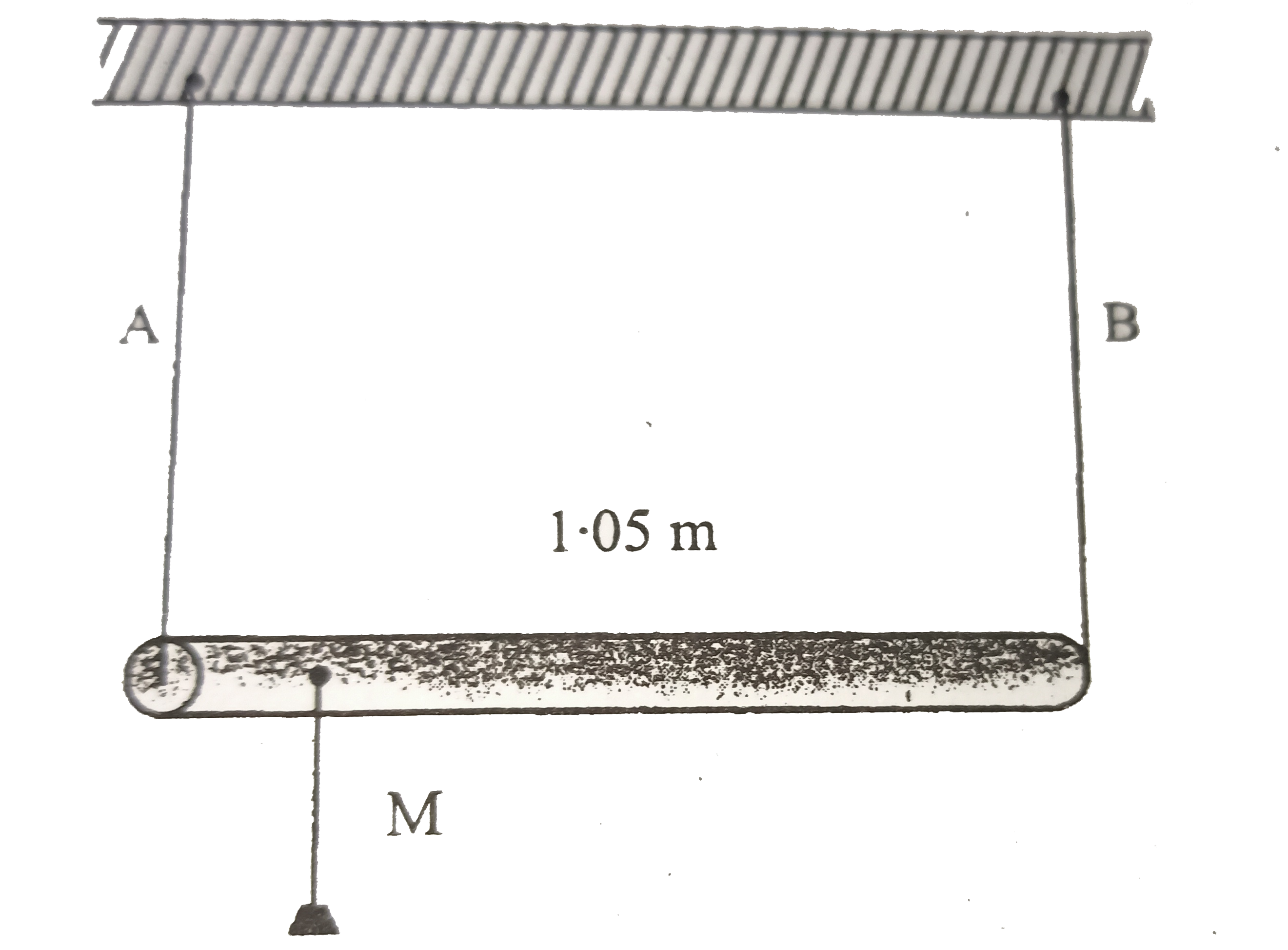A rod of length 1.05 m having negligible mass is supported at its ends by two wires of steel wire A and aluminium wire B of equal lengths as shown in Fig. 9.15. The crosssectional areas of wires A and B are 1.0 mm2 and 2.0 mm2 respectively. At what point along the rod should a mass m be suspended in order to produce a equal stresses and b equal strains in both steel and aluminium wires.
a 0.7 m from the steel-wire end 0.432 m from the steel-wire endCross-sectional area of wire A a1 = 1.0 mm2 = 1.0 × 10–6 m2Cross-sectional area of wire B a2 = 2.0 mm2 = 2.0 × 10–6 m2Young’s modulus for steel Y1 = 2 × 1011 Nm–2Young’s modulus for aluminium Y2 = 7.0 ×1010 Nm–2Let a small mass m be suspended to the rod at a distance y from the end where wire A is attached.F1 = Force exerted on the steel wireF2 = Force exerted on the aluminum wireThe situation is shown in the following figure.Taking torque about the point of suspension we have:Using equations i and ii we can write:In order to produce an equal stress in the two wires the mass should be suspended at a distance of 0.7 m from the end where wire A is attached.If the strain in the two wires is equal then:Taking torque about the point where mass m is suspended at a distance y1 from the side where wire A attached we get:In order to produce an equal strain in the two wires the mass should be suspended at a distance of 0.432 m from the end where wire A is attached.
Related Solutions
A rod of length 1.05 m having negligible mass supported at its ends by two wires of steel (wire A) and aluminium (wire B) of equal lengths as shown in respectively. At what point along the rod should a mass m be suspended in order to produce (a) equal stresses and (b) equal strains in both steel and aluminium wires.

View SolutionA rod of length 1.05 m having negligible mass supported at its ends by two wires of steel (wire A) and aluminium (wire B) of equal lengths as shown in respectively. At what point along the rod should a mass m be suspended in order to produce (a) equal stresses and (b) equal strains in both steel and aluminium wires.
View SolutionA rod of length 1.05 m having negligible mass is supported at its ends by two wires of steel (wire A) and aluminium (wire B) of equal lengths as shown in Fig. 9.15. The cross-sectional areas of wires A and B are 1.0 mm^2 and 2.0 mm^2 , respectively. At what point along the rod should a mass m be suspended in order to produce equal strains in both steel and aluminium wires.:
View SolutionA rod of length 1.05 m having negligible mass is supported at its ends by two wires of steel (wire A) and aluminium (wire B) of equal lengths as shown in figure. The cross-sectional areas of wires A and B are 1.0 mm^(2) and 2.0 mm^(2), respectively. At what point along the rod should a mass m be suspended in order to produce (a) equal stresses and (b) equal strains in both steel and aluminium wires.
View SolutionA rod of length 1.05 m having negligible mass is supported at its ends by two wires of steel (wire A) and aluminium (wire B) of equal lengths as shown in Fig. 9.15. The cross-sectional areas of wires A and B are , respectively. At what point along the rod should a mass m be suspended in order to produce (a) equal stresses :

View SolutionA rod of length 1.05 m having negligible mass is supported at its ends by two wires of steel (wire A) and aluminium (wire B) of equal length as shown in the figureThe cross sectional area of wires A and B are 1.0 mm^2 and 2.0 mm^2 , respectivley. AT wat point along the rod should a mass m be suspended in order to produce equal strains in both steel and aluminium wires?
View SolutionA rod of length 1.05 m having negligible mass is supported at its ends by two wires of steel (wire A) and aluminium (wire B) of equal length as shown in the figure The cross sectional area of wires A and B are 1.0 mm^2 and 2.0 mm^2 , respectivley. AT wat point along the rod should a mass m be suspended in order to produce .equal stresses.
View SolutionA rod of length having negligible mass is supported at its ends by two wires one of stell (wire ), and the other of aluminium (wire ) of equal lengths as shown in fig. The cross-sectional areas of wires and are and respectively. At what point along the rod a load be suspended in order to produce
(a) equal stress, (b) equal strains in both steel an aluminium.

View SolutionA rod of length 1.05 m having negliaible mass is supported at its ends by two wires of steel (wire A) and aluminium (wire B) of equal lengths as shown in fig. The cross-sectional area of wire A and B are and 2, respectively . At what point along the rod should a mass m be suspended in order to produce (a) equal stresses and (b) equal strains in both steel and aluminium wires. Given,

View SolutionA rod of length 1.05 m having negliaible mass is supported at its ends by two wires of steel (wire A) and aluminium (wire B) of equal lengths as shown in fig. The cross-sectional area of wire A and B are and 2, respectively . At what point along the rod should a mass m be suspended in order to produce (a) equal stresses and (b) equal strains in both steel and aluminium wires. Given,

View SolutionA rod of length 1.05 m having negliaible mass is supported at its ends by two wires of steel (wire A) and aluminium (wire B) of equal lengths as shown in fig. The cross-sectional area of wire A and B are 1 mm^(2) and 2 mm^(2) , respectively . At what point along the rod should a mass m be suspended in order to produce (a) equal stresses and (b) equal strains in both steel and aluminium wires. Given, Y_(steel) = 2 xx 10^(11) Nm^(-2) and Y-(alumi n i um) = 7.0 xx 10^(10)N^(-2)
View Solution1.05 m લંબાઈ અને અવગણ્ય દળ ધરાવતાં એક સળિયાને આકૃતિ 9.15માં દર્શાવ્યા મુજબ બે તાર વડે બંને છેડેથી લટકાવેલ છે. તાર A સ્ટીલ અને તાર B ઍલ્યુમિનિયમનો છે. તાર A અને તાર Bના આડછેદનું ક્ષેત્રફળ અનુક્રમે અને છે. સળિયા પર કયા બિંદુએ m દળ લટકાવવામાં આવે કે જેથી સ્ટીલ અને ઍલ્યુમિનિયમના બંને તારમાં. (b) સમાન વિકૃતિ ઉદ્ભવે ?

View Solutionm लंबाई तथा नगण्य द्रव्यमान की एक छड़ को बराबर लंबाई के दो तारों, एक इस्पात का ( तार A ) तथा दूसरा ऐल्युमिनियम का तार ( तार B ) द्वारा सिरों से लटका दिया गया है, जैसा कि चित्र में दिखाया गया है। A तथा B के तारों के अनुप्रस्थ परिच्छेद के क्षेत्रफल क्रमशः और हैं। छड़ के किस बिंदु से एक द्रव्यमान M को लटका दिया जाए ताकि इस्पात तथा ऐल्युमिनियम के तारों में (a) समान प्रतिबल तथा (b) समान विकृति उत्पन्न हो ?

View Solution1.05 m લંબાઈ અને અવગણ્ય દળ ધરાવતાં એક સળિયાને આકૃતિ 9.15માં દર્શાવ્યા મુજબ બે તાર વડે બંને છેડેથી લટકાવેલ છે. તાર A સ્ટીલ અને તાર B ઍલ્યુમિનિયમનો છે. તાર A અને તાર Bના આડછેદનું ક્ષેત્રફળ અનુક્રમે અને છે. સળિયા પર કયા બિંદુએ m દળ લટકાવવામાં આવે કે જેથી સ્ટીલ અને ઍલ્યુમિનિયમના બંને તારમાં (a) સમાન પ્રતિબળ ?

View Solution1.05 m लम्बाई तथा नगण्य द्रव्यमान कि एक छड़ को बराबर लम्बाई के दो तारो , एक इस्पात का (तार A) तथा दूसरे ऐलुमिनियम का तार (तार B) द्वारा सिरों से लटका दिया गया है, जैसे कि चित्र में दिखाया गया है। A तथा B के तारो से अनुप्रस्थ प्रतिच्छेद के क्षेत्रफल क्रमश: और है। छड़ से कितनी दूर बिंदु से एक द्रव्यमान m को लटका दिया जाए ताकि इस्पात तथा ऐलुमिनियम के तारो में (A) समान प्रतिबल तथा (B) समान विकृति उत्पन्न हो।

View SolutionA rod of length l and negligible mass is suspended at its two ends by two wires of steel (wire A ) and aluminium (wire B) of equal length (shown in the figure) The cross-sectional areas of wires A and B are 1.0 mm^2 and 2.0 mm^2 , respectively. (Y_(AL) = 70 xx 10^9 N m^-2 and y _(steel) = 200 xx 10^9 N m^-2)
View SolutionA rod of length 1 and negligible mass is suspended at its two ends by two wires of steel (wire A) and aluminium (wire B) of equal lengths as shown in figure. The cross-sectional areas of wires A and B are 1.0 mm^(2) and 2.0 mm^(2) respectively. Y_("steel”) = 200 xx 10 ^(9) Nm ^(-2) and Y_("auminium”) = 70 xx 10 ^(9) Nm ^(-2)
View SolutionAn iron rod B of length 1 m and mass 1 kg is suspended with help of two wires as shwon in figure. The area of cross-section of iron wire is 0.3 cm^(2) and of copper wire is 0.6cm^(2) . At what distance from iron wire a weight can be hung to produce equal stress in wires?
View SolutionA rod of length 1.05 m having negliaible mass is supported at its ends by two wires of steel (wire A) and aluminium (wire B) of equal lengths as shown in fig. The cross-sectional area of wire A and B are and 2, respectively . At what point along the rod should a mass m be suspended in order to produce (a) equal stresses and (b) equal strains in both steel and aluminium wires. Given,

View Solutionएक मी लम्बाई की एक छड़ जिसका भार नगण्य है तो तारो [एक स्टील (तारA )तथा दूसरा एल्युमिनियम (तार B) के सिरों द्वारा जुड़ी हुई है तार A व B के अनुप्रस्थ -काट के क्षेत्रफल क्रमशः तथा है
A से किस बिंदु पर छड़ के सापेक्ष एक भार लटकाया जाए तो उत्प्पन्न

समान प्रतिबल दोनों स्टील तथा एल्युमिनियम तारो के लिए क्या है ?
View Solution